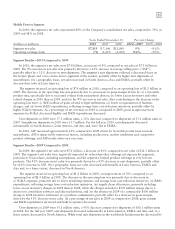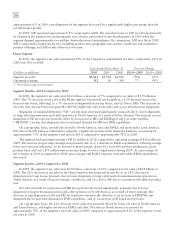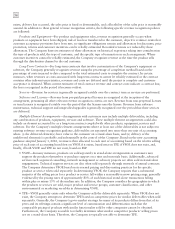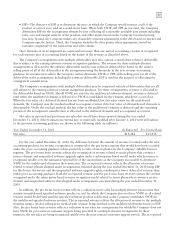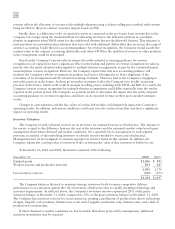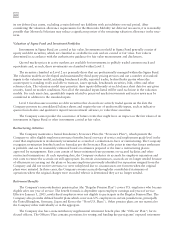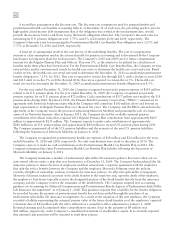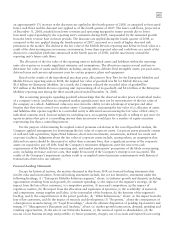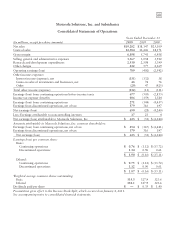Motorola 2010 Annual Report Download - page 71
Download and view the complete annual report
Please find page 71 of the 2010 Motorola annual report below. You can navigate through the pages in the report by either clicking on the pages listed below, or by using the keyword search tool below to find specific information within the annual report.
63
The net periodic pension cost for these split-dollar life insurance arrangements was $5 million and $6 million
for both the years ended December 31, 2010 and 2009, respectively. The Company has recorded a liability
representing the actuarial present value of the future death benefits as of the employees’ expected retirement date of
$51 million and $48 million as of December 31, 2010 and December 31, 2009, respectively.
The Company’s measurement date of its plan assets and obligations is December 31.
Valuation and Recoverability of Goodwill and Long-lived Assets
The Company tests the recorded amount of goodwill for recovery on an annual basis in the fourth quarter of
each fiscal year. Goodwill is tested more frequently if indicators of impairment exist. The Company continually
assesses whether any indicators of impairment exist, which requires a significant amount of judgment. Such
indicators may include: a sustained significant decline in its share price and market capitalization; a decline in its
expected future cash flows; a significant adverse change in legal factors or in the business climate; unanticipated
competition; the testing for recoverability of a significant asset group within a reporting unit; or slower growth
rates, among others. Any adverse change in these factors could have a significant impact on the recoverability of
these assets and could have a material impact on our combined financial statements.
The goodwill impairment test is performed at the reporting unit level. A reporting unit is an operating segment
or one level below an operating segment (referred to as a “component”). A component of an operating segment is a
reporting unit if the component constitutes a business for which discrete financial information is available and
segment management regularly reviews the operating results of that component. When two or more components of
an operating segment have similar economic characteristics, the components shall be aggregated and deemed a single
reporting unit. An operating segment shall be deemed to be a reporting unit if all of its components are similar, if
none of its components is a reporting unit, or if the segment comprises only a single component. As such, the
Company has determined that the Mobile Devices segment meets the requirement of a reporting unit. For the
Enterprise Mobility Solutions segment, the Company has identified two reporting units, the Government and Public
Safety reporting unit and the Enterprise Mobility reporting unit. For the Home segment, the Company has identified
two reporting units, the Broadband Home Solutions reporting unit and the Access Networks reporting unit.
The goodwill impairment test is a two step analysis. In Step One, the fair value of each reporting unit is
compared to its book value. Management must apply judgment in determining the estimated fair value of these
reporting units. Fair value is determined using a combination of present value techniques and quoted market prices
of comparable businesses. If the fair value of the reporting unit exceeds its book value, goodwill is not deemed to be
impaired for that reporting unit, and no further testing would be necessary. If the fair value of the reporting unit is
less than its book value, the Company performs Step Two. Step Two uses the calculated fair value of the reporting
unit to perform a hypothetical purchase price allocation to the fair value of the assets and liabilities of the reporting
unit. The difference between the fair value of the reporting unit calculated in Step One and the fair value of the
underlying assets and liabilities of the reporting unit is the implied fair value of the reporting unit’s goodwill. A
charge is recorded in the financial statements if the carrying value of the reporting unit’s goodwill is greater than its
implied fair value.
The following describes the valuation methodologies used to derive the fair value of the reporting units:
•Income Approach: To determine fair value, the Company discounts the expected future cash flows of the
reporting units. The discount rate used represents the estimated weighted average cost of capital, which
reflects the overall level of inherent risk involved in our operations and the rate of return a market
participant would expect to earn. To estimate cash flows beyond the final year of our model, the Company
uses a terminal value approach. Under this approach, the Company uses estimated operating income before
interest, taxes, depreciation and amortization in the final year of its model, adjusts it to estimate a
normalized cash flow, applies a perpetuity growth assumption and discounts it by a perpetuity discount
factor to determine the terminal value. The Company incorporates the present value of the resulting terminal
value into its estimate of fair value.
•Market-Based Approach: To corroborate the results of the income approach described above, the Company
estimated the fair value of its reporting units using several market-based approaches, including the value that
is derived based on Motorola Solutions’ consolidated stock price as described above. The Company also uses
the guideline company method, which focuses on comparing our risk profile and growth prospects to select
reasonably similar/guideline publicly traded companies.


